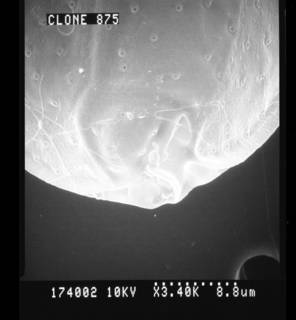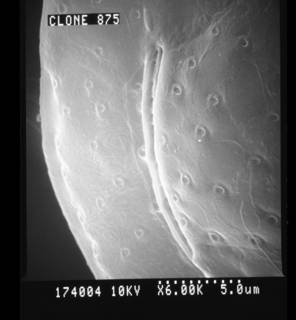
| Intro | | Search taxa | | Browse taxa | | Distributions | | Terminology | | References | | Statistics | | Online sources | | Tutorial | | Log in |
WoRMS taxon detailsOstreopsis lenticularis Y.Fukuyo, 1981
231881 (urn:lsid:marinespecies.org:taxname:231881)
accepted
Species
marine,
Fukuyo Y. 1981. Taxonomical study on benthic dinoflagellates collected in coral reefs. Bull. Jap. Soc. Sci. Fish. 47: 967-978. [details]
Type locality contained in Tahiti Island
type locality contained in Tahiti Island [details]
LSID urn:lsid:algaebase.org:taxname:42625
LSID urn:lsid:algaebase.org:taxname:42625 [details] Description Cells lenticulate, pointing ventrally and compressed antero-posteriorly. Epitheca and hypotheca have almost the same...
Description Cells lenticulate, pointing ventrally and compressed antero-posteriorly. Epitheca and hypotheca have almost the same height. Plate pattern and shape are similar to that of O. siamensis (Fukuyo 1981) but the main distinctive feature is the presence of two types of pores, large and small visible in LM (cf. Fig. 33 in Fukuyo 1981), and the absence of undulation of the cingulum. [details]
Guiry, M.D. & Guiry, G.M. (2025). AlgaeBase. World-wide electronic publication, National University of Ireland, Galway (taxonomic information republished from AlgaeBase with permission of M.D. Guiry). Ostreopsis lenticularis Y.Fukuyo, 1981. Accessed through: World Register of Marine Species at: https://www.marinespecies.org/aphia.php?p=taxdetails&id=231881 on 2025-02-05
Date action by 2006-07-28 07:22:01Z changed Camba Reu, Cibran 2015-06-26 12:00:51Z changed db_admin Copyright notice: the information originating from AlgaeBase may not be downloaded or replicated by any means, without the written permission of the copyright owner (generally AlgaeBase). Fair usage of data in scientific publications is permitted.
original description
Fukuyo Y. 1981. Taxonomical study on benthic dinoflagellates collected in coral reefs. Bull. Jap. Soc. Sci. Fish. 47: 967-978. [details]
basis of record Gómez, F. (2005). A list of free-living dinoflagellate species in the world's oceans. <em>Acta Bot. Croat.</em> 64(1): 129-212. [details] additional source Streftaris, N., A. Zenetos & E. Papathanassiou. (2005). Globalisation in marine ecosystems: the story of non-indigenous marine species across European seas. <em>Oceanogry and Marine Biology: an Annual Review.</em> 43: 419-453. (look up in IMIS) [details] Available for editors additional source Guiry, M.D. & Guiry, G.M. (2024). AlgaeBase. <em>World-wide electronic publication, National University of Ireland, Galway.</em> searched on YYYY-MM-DD., available online at http://www.algaebase.org [details] additional source Tomas, C.R. (Ed.). (1997). Identifying marine phytoplankton. Academic Press: San Diego, CA [etc.] (USA). ISBN 0-12-693018-X. XV, 858 pp., available online at http://www.sciencedirect.com/science/book/9780126930184 [details] additional source Zenetos, A.; Çinar, M.E.; Pancucci-Papadopoulou, M.A.; Harmelin, J.-G.; Furnari, G.; Andaloro, F.; Bellou, N.; Streftaris, N.; Zibrowius, H. (2005). Annotated list of marine alien species in the Mediterranean with records of the worst invasive species. <em>Mediterranean Marine Science.</em> 6 (2): 63-118., available online at https://www.researchgate.net/publication/273213810_Annotated_list_of_marine_alien_species_in_the_Mediterranean_with_records_of_the_worst_invasive_species [details] Available for editors additional source Steidinger, K. A., M. A. Faust, and D. U. Hernández-Becerril. 2009. Dinoflagellates (Dinoflagellata) of the Gulf of Mexico, Pp. 131–154 in Felder, D.L. and D.K. Camp (eds.), Gulf of Mexico–Origins, Waters, and Biota. Biodiversity. Texas A&M Press, College [details] additional source Moestrup, Ø., Akselman, R., Cronberg, G., Elbraechter, M., Fraga, S., Halim, Y., Hansen, G., Hoppenrath, M., Larsen, J., Lundholm, N., Nguyen, L. N., Zingone, A. (Eds) (2009 onwards). IOC-UNESCO Taxonomic Reference List of Harmful Micro Algae., available online at http://www.marinespecies.org/HAB [details] additional source Chang, F.H.; Charleston, W.A.G.; McKenna, P.B.; Clowes, C.D.; Wilson, G.J.; Broady, P.A. (2012). Phylum Myzozoa: dinoflagellates, perkinsids, ellobiopsids, sporozoans, in: Gordon, D.P. (Ed.) (2012). New Zealand inventory of biodiversity: 3. Kingdoms Bacteria, Protozoa, Chromista, Plantae, Fungi. pp. 175-216. [details] toxicology source Meunier F.A., Mercado J.A., Molgo J., Tosteson T.R. & Gotta G.E. 1997. Selective depolarization of the muscle membrane in frog nerve-muscle preparations by a chromatographically purified extract of the dinoflagellate <i>Ostreopsis lenticularis</i>. Brit. J. Pharmacol. 121: 1224-1230. [details] toxicology source Lenoir S., Ten-Hage L., Turquet J., Quod J.-P., Bernard C. & Hennion M.-C. 2004. First evidence of palytoxin analogues from an <i>Ostreopsis mascarenensis</i> (Dinophyceae) benthic bloom in Southwestern Indian Ocean. J. Phycol. 40: 1042-1051. [details] ecology source Leles, S. G.; Mitra, A.; Flynn, K. J.; Tillmann, U.; Stoecker, D.; Jeong, H. J.; Burkholder, J.; Hansen, P. J.; Caron, D. A.; Glibert, P. M.; Hallegraeff, G.; Raven, J. A.; Sanders, R. W.; Zubkov, M. (2019). Sampling bias misrepresents the biogeographical significance of constitutive mixotrophs across global oceans. <em>Global Ecology and Biogeography.</em> 28(4): 418-428., available online at https://doi.org/10.1111/geb.12853 [details] Available for editors ecology source Mitra, A.; Caron, D. A.; Faure, E.; Flynn, K. J.; Leles, S. G.; Hansen, P. J.; McManus, G. B.; Not, F.; Do Rosario Gomes, H.; Santoferrara, L. F.; Stoecker, D. K.; Tillmann, U. (2023). The Mixoplankton Database (MDB): Diversity of photo‐phago‐trophic plankton in form, function, and distribution across the global ocean. <em>Journal of Eukaryotic Microbiology.</em> 70(4)., available online at https://doi.org/10.1111/jeu.12972 [details] ecology source Faust, M.A. (1998). Mixotrophy in tropical benthic dinoflagellates. In: Reguera, B., Blanco, J., Fernandez, L., Wyatt, T. (Eds.), Harmful Algae. Proceedings of the VIII International Conference on Harmful Algae, Vigo, Spain, 1997, Xunta de Galicia and Intergovernmental Oceanographic Commission of UNESCO, Paris, France, pp. 390–393. [details]  Present Present  Present in aphia/obis/gbif/idigbio Present in aphia/obis/gbif/idigbio  Inaccurate Inaccurate  Introduced: alien Introduced: alien  Containing type locality Containing type locality
From editor or global species database
LSID urn:lsid:algaebase.org:taxname:42625 [details]From regional or thematic species database
Description Cells lenticulate, pointing ventrally and compressed antero-posteriorly. Epitheca and hypotheca have almost the same height. Plate pattern and shape are similar to that of O. siamensis (Fukuyo 1981) but the main distinctive feature is the presence of two types of pores, large and small visible in LM (cf. Fig. 33 in Fukuyo 1981), and the absence of undulation of the cingulum. [details] Harmful effect Species is not toxic (Chomerat et al. 2019). Previously reported to be toxic by Tindall et al. (1990), but probably mistaken with O. siamensis (see discussion in Chomérat et al. 2019) [details] Identification Contrary to the statement by Penna et al. (2005) that the elongated or rounded shape is one of the main differences between O. lenticularis and O. siamensis, Fukuyo (1981) clearly indicated that the two species have a similar size, outline and thecal plate pattern. Using SEM, Faust et al. (1996) identified specimens with only one type of pore as O. lenticularis, which differs from the original description of the species, and this organism likely belongs to another taxon. [details] |



